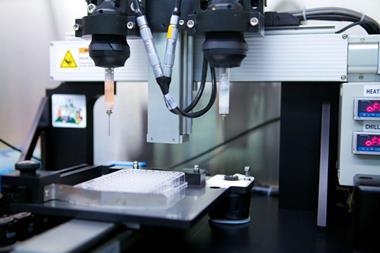Stereolithography technique is 100 times faster than current technologies and could open the door to mass production with 3D printing
A new, continuous-flow process for stereolithography – one of the key technologies in 3D printing – that is 25–100 times faster than current technologies and of higher quality has been developed by researchers in the US. The team believes the technology may allow 3D printing to move beyond visualisation and prototyping niches and find a home in mass production, although other researchers remain sceptical.
In traditional stereolithography, ultraviolet light traces out a pattern in a special, photo-activated resin, producing free radicals, which polymerise the resin into a layer of solid polymer. By building up thousands of layers a three-dimensional object can be created. The process is currently extremely slow, taking hours to produce an object just a few centimetres in height.
Oxygen is usually excluded during stereolithography, as it inhibits free-radical polymerisation and produces an incompletely-cured, tacky object. In the new work, however, researchers at the University of North Carolina in Chapel Hill and the technology company Carbon3D in California turn it to their advantage. They use a bath of liquid resin with a base permeable to oxygen and ultraviolet light. By supplying the base with oxygen, they create a micrometre-scale ‘dead zone’ at the bottom of the bath in which polymerisation cannot occur. Illuminating the base with patterned ultraviolet light only polymerises a layer just above the dead zone.
As a column of resin is drawn upwards out of the bath, fresh resin flows in at the bottom through the dead zone, allowing a three-dimensional object to be drawn out of the bath at speeds of up to 1 metre per hour, depending on the resolution required. By varying the pattern of ultraviolet light, the researchers can shape the 3D object emerging from the bath. Using this technique the researchers produced a variety of shapes, from an array of micrometre-scale paddles to a 10cm model of the Eiffel Tower. The model of the Eiffel tower took more than 100 times longer to produce on an ordinary stereolithography machine.
One of the inventors of the technology, Joseph DeSimone, says that the research opens the door to mass production using 3D printing. ‘If you look at injection moulding times we are competing with curing times on the order of 15–20 minutes for some resins, whether it’s automotive parts or other injection moulding chemistries,’ he says.
Materials scientist Brian Derby of the University of Manchester, UK, and Richard Hague of the University of Nottingham, UK, both describe the research as ‘interesting’ but foresee challenges. ‘Personally, I think the major problem with 3D printing is not the speed, which is a problem, but it’s the material palate,’ Derby says. Hague agrees: ‘They show a bouncing ball, for example. But would it still have those mechanical properties in a year’s time? I think that’s going to be the challenge for them.’












No comments yet